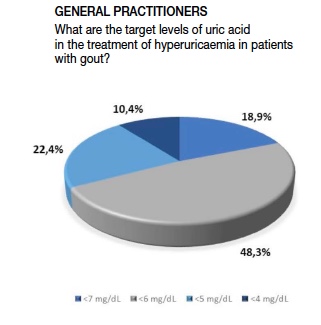Understanding and perceptions of gout: an interdisciplinary assessment among patients, physicians and pharmacists in Italy

Submitted: 29 March 2019
Accepted: 17 December 2019
Published: 10 April 2020
Accepted: 17 December 2019
Abstract Views: 1195
PDF: 783
Publisher's note
All claims expressed in this article are solely those of the authors and do not necessarily represent those of their affiliated organizations, or those of the publisher, the editors and the reviewers. Any product that may be evaluated in this article or claim that may be made by its manufacturer is not guaranteed or endorsed by the publisher.
All claims expressed in this article are solely those of the authors and do not necessarily represent those of their affiliated organizations, or those of the publisher, the editors and the reviewers. Any product that may be evaluated in this article or claim that may be made by its manufacturer is not guaranteed or endorsed by the publisher.
Similar Articles
- G. Pasero, P. Marson, Wars in the history of rheumatology , Reumatismo: Vol. 59 No. 4 (2007)
- M. Skoczynska, F. Figus, V. Arena, G. Massazza, A. Iagnocco, The role of PET in a clinically silent and ultrasound negative synovitis in the course of rheumatoid arthritis - a case report , Reumatismo: Vol. 73 No. 1 (2021)
- M. Polastri, G.M. Paganelli, G. Dolci, E. Di Ciaccio, I. Prediletto, Musculoskeletal syndrome treated with global postural re-education in double-redo lung transplantation: a case report with an 8-month follow-up , Reumatismo: Vol. 74 No. 1 (2022)
- G. Adami, L. Idolazzi, C. Benini, E. Fracassi, A. Carletto, O. Viapiana, D. Gatti, M. Rossini, A. Fassio, Secukinumab retention rate is greater in patients with psoriatic arthritis presenting with axial involvement , Reumatismo: Vol. 75 No. 1 (2023)
- A. Farina, E. Filippucci, W. Grassi, Sonographic findings of the synovial fluid , Reumatismo: Vol. 54 No. 3 (2002)
- S. Zeni, F. Ingegnoli, Raynaud’s phenomenon , Reumatismo: Vol. 56 No. 2 (2004)
- G. Valesini, M. Cutolo, Effects of TNF antagonists on immune and neuroendocrine system , Reumatismo: Vol. 57 No. s4 (2005)
- G. Brambilla, A. Brucato, Y. Adler, M. Bosetti, P. Coppini, A. Caforio, D. Spodick, B. Canesi, Recurrent acute idiopathic pericarditis: rheumatologic therapy, autoantibodies and long term outcome , Reumatismo: Vol. 59 No. 1 (2007)
- S. Adami, F. Bertoldo, M.L. Brandi, C. Cepollaro, P. Filipponi, E. Fiore, B. Frediani, S. Giannini, S. Gonnelli, G.C. Isaia, G. Luisetto, E. Mannarino, C. Marcocci, L. Masi, C. Mereu, S. Migliaccio, S. Minisola, R. Nuti, G. Rini, M. Rossini, M. Varenna, L. Ventura, G. Bianchi, Guidelines for the diagnosis, prevention and treatment of osteoporosis , Reumatismo: Vol. 61 No. 4 (2009)
- Z. Ahmadinejad, R. Assari, N. Ayoobi Yazdi, S.-H. Mazloomi, P. Javanshayani, H. Khalili Afousi, V. Ziaee, COVID-19 pandemic and biological therapy in rheumatologic disorders: how to deal with? , Reumatismo: Vol. 72 No. 3 (2020)
<< < 20 21 22 23 24 25 26 27 28 > >>
You may also start an advanced similarity search for this article.

 https://doi.org/10.4081/reumatismo.2020.1227
https://doi.org/10.4081/reumatismo.2020.1227




